
Are we going vegetarian this year? Shall we keep the dessert the same? Where do I find inspiration for a festive meal during the holidays? For readers who like to postpone these questions, for those who like to tell a good story with their culinary contribution, or for those who simply want to know more about food culture, we made this reading list. A list full of inspiring and tasty reading material. Books that are just begging to be devoured.
All books in the list below are held in the collections of Leiden University Libraries (UBL), and represent just a small selection of the books we own about food and food culture. To borrow a book from the list, follow the link below the title. Find hundreds of other titles by searching our Catalogue.
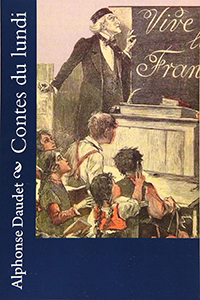
Alphonse Daudet, Les trois messes basses (Uit de bundel Contes de lundi)
1873
Alphonse Daudet (1840-1897) was a French writer that older readers may remember from their schooldays. His Lettres de mon moulin (1869) was often the first French book that one would read. Les trois messes basses (1869) was added to a later edition of this book, but had appeared already in 1873 in Contes du Lundi. The short story deals with both Christmas and gluttony. A perfect start to this list.
The main character is the priest Balaguère, who has to celebrate the traditional three masses on Christmas Eve before the réveillon, the nocturnal banquet begins. De devil, impersonating altar boy Garrigou, spurs Balaguère on with his altar bell (drelindin din!) to rush his holy duties. Balaguère massively overeats at the Réveillon, for which he is punished. The story ends with a deep, ghostly moral.
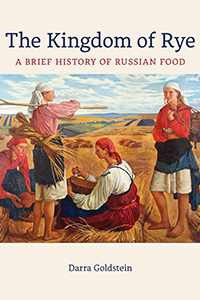
Darra Goldstein, The Kingdom of Rye: a brief history of Russian food
2022
In The Kingdom of Rye, the American professor and food expert Derra Goldstein takes the reader on a journey through a thousand years of Russian cooking. Though concise (the book is a mere 150 pages long, in three chapters), she nevertheless covers the essence of Russian food culture in a compelling and accessible way. Throughout the centuries, Russian cuisine has been defined by what the land and climate had to offer ('The Land and Its Flavors'), including the darker periods of czarist Russia and the Soviet-Union ('Hardship and Hunger'), but also brighter instances of hospitality and abundance, that is to say, for those who could afford it ('Hospitality and Excess'). It's not without reason that the book is titled Kingdom of Rye: a good slab of coarse rye bread is at the heart of every traditional Russian meal. As a result of the colonization of Siberia, Ukraine, the Caucasus, and Central Asia, the kitchen has diversified throughout the centuries. Some of these new dishes have become so well-known that we consider them to be typically Russian. The beet soup borscht, for example, doesn't belong to the Russian, but to the Ukrainian kitchen. Its Russian counterpart, cabbage soup, is just as difficult to pronounce: shtschi. Goldstein is well-informed and gives insight into the fascinating food culture and, simultaneously, the broader cultural history of Russia.
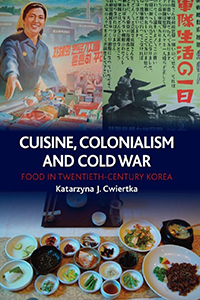
Katarzyna Cwiertka, Cuisine, colonialism and Cold War: food in twentieth-century Korea
2012
Unesco's Representative List of Intangible Cultural Heritage is increasingly being expanded with food items and beverages. In 2022, the North Korean raengmyon (cold noodle soup) was added to the List. An interesting move, seeing as this dish is increasingly popular in South Korea and the countries are technically still at war, after seventy years of conflict. The contemporary history of Korean cuisine is closely interwoven with the dynamic geopolitical changes on the Korean peninsula in the twentieth century. Cuisine, Colonialism and Cold War describes how these developments are reflected in Korean food culture. From colonial repression and war to democratisation and globalisation. The book is based on solid academic research, as well as accessibly written and richly illustrated. In six chronologically ordered chapters, various topics are discussed, like industrialization, the production of soy sauce, the advent of Japanese and European restaurants, and American influences. We observe how South Koreans increasingly value their own culinary traditions as their standard of living grows, while North Koreans suffer from protracted food shortages. A must read for everyone interested in the history of Korean food culture.
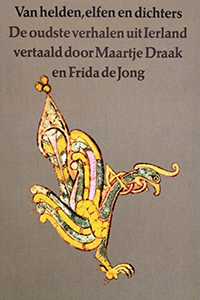
Anon. - Het zwijn van MacDathó
ca. 800
A story from the rich medieval Irish literature: MacDathó, king of Leinster, posesses a beautiful dog, that is requested by the kings of both Ulster and Connacht. To escape this dilemma, he invites the heroes of both districts/kingdoms/provinces for a feast. A quarrel ensues about who may serve himself first: the first portion, called curadmír or champion's portion, is for the strongest in the company. He who claims it, is challenged by a hero from the opposing party: "it is intolerable that you should take precedence in dividing the pig, You cast a spear at me so that it stuck out of my shield. I cast the spear back at you so that it pierced your head and put out your eye." If a champion is thus put in his place, the author straightforwardly observes: dessid side dano "thereupon the other sat down". In the end it is Conall Cernach who divides the pig, with which he manages to offend the Connacht men deeply once again. Gluttony and pride lead to a bloody but satisfying end to the story.
A Dutch translation by Maartje Draak and Frida de Jong was published in Van helden, elfen en dichters: de oudste verhalen uit Ierland (1979). Those who want to learn to read this story in the original language can turn to Winfred Lehmann's An Introduction to Old-Irish (c. 1975) a textbook that uses the Tale of MacDathó's Pig as teaching material.
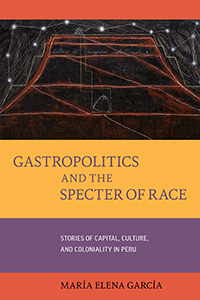
María Elena García, Gastropolitics and the Specter of Race : Stories of Capital, Culture, and Coloniality in Peru
2021
During the 20th century, Peru was typically seen as a dangerous place to visit due to the prevalent political violence. Nowadays, however, Peru is perhaps best known internationally for its cuisine, which is touted to be the unique result of a cultural fusion, where 'Indigenous' meets 'Western'. This image seems to displace the previous assumptions about Peru as a dangerous place to visit and establishes new discourses centred around the cultural significance of food. It is these new discourses and ideas that Elena María Garcia critically engages with in this work. She argues that, at the heart of the narratives surrounding Peruvian cuisine, a critical reading is possible, which would expose the links between gastronomy and violence in Peru through an analysis of the intersections of race, species and capital. Ranging from critical readings of high-end menus, ethnographic analysis of culinary festivals, guinea pig production, and national-branding campaigns, this book offers a great insight into the politics related to the production, branding and cultural conceptions around food.
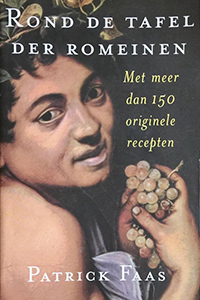
Patrick Faas, Rond de tafel der Romeinen
1994
On Cookery (or, in Latin, De Re Coquinaria) is the only gastronomic text that has come down to us from classical Antiquity. It dates from the fourth century AD and is nothing less than a compilation of the secrets of Roman cuisine. It consists of 470 'recipes' (albeit without any sort of modern instructions). Its true author remains unknown, although the groundwork appears to have been done by a certain Marcus Gavinius Apicius, a wealthy gourmand who lived under emperor Tiberius (14-37 AD).
He is credited with many of the culinary inventions that made the imperial dining tables so infamous and notorious. 'Apicius, the greatest and most prodigal gourmand of all, proclaimed the view that the tongue of the flamingo is highly delicious' (Pliny, Natural History 10. 68). It appears his name became proverbial for any later Roman cook aspiring to be a 'gourmet' chef. The main historical importance of the text lies in the fact that it confirms the use of meat and meat sauces in expensive Roman cuisine, and the use of a range of exotic and costly spices in such dishes.
Using 'Apicius' as his main source Dutch author Patrick Faas delves into the fascinating world of ancient food culture. His resulting hybrid cook book provides a portrait of Roman society from the vantage point of the dining table, kitchen, and market stalls, with 150 recipes reconstructed for the modern cook. We may well say with him: miraberis ('You'll be amazed') after tasting 'Terentine Sea-Boar Ham', 'Peas or Beans Vitellian', or Gourds Alexandrine!
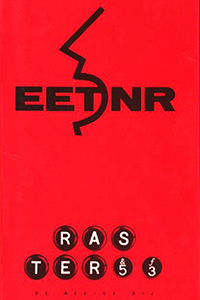
Raster #53 Eetnummer
1991
In 1991, the illustrious Dutch literary journal Raster published an edition that had 'Eating' as its theme. Like all issues of Raster, this 'eating edition' consists mainly of international literature in Dutch translation. For this edition,the Dutch professor of Chinese language and literature Maghiel van Crevel (Leiden University) translated poetry from the Chinese poet and author Duoduo, who lived in exile since the student protests of 1989 but returned to China in 2004: 'Let's talk about the Chinese kitchen. It consists of eight categories of dishes, hundreds and thousands of cookbooks; they call her highly developed and rightly so. It has sour, sweet, bitter and hot dishes, in all possible colors, smells and flavours; they praise her richness, and rightly so. Once you're used to Chinese food, your taste buds will find other food rather tasteless.' Another inventory comes from Georges Perec, who kept track of the 'fluid and solid food' that he had 'gobbled up' in the course of a year. Nine beef broth, one iced cucumber soup, one mussel soup. Two Guéméné andouilles, one jellied andouillette, one Italian charcuterie, one saveloy, four mixed charcuteries, one coppa, three pork platters, one figatelli, one foie gras, one fromage de tête, one boar's head, five Parma hams,' and this continues for six more pages. Apart from the texts by Duoduo and Perec, the issue contains texts from writers and poets such as Roland Barthes, Giorgio Manganelli, Carlo Emilio Gadda, Piero Camporesi, Henry Fielding, and Francis Ponge.
Do you have any suggestions for this list? Or would you like to make a purchase request for a book not yet in the UBL collections? Contact us via Ask a librarian or share your thoughts via Twitter, Facebook of Instagram.






